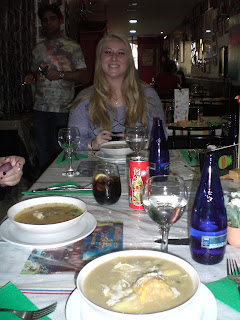I'm a few weeks behind on my blog... I've started operating on Spanish time, though, so I'm not too worried about it. ;) Two weekends ago (Feb. 8) we had an ISA (my study abroad group) excursion to Sevilla. I had to get up at the crack of dawn, AKA 7:30, for the 4 hour bus ride south.
We arrived in the late afternoon and took a short walking tour of the city. Historically, Sevilla is considered one of the 3 most important Spanish cities (along with Madrid & Barcelona). How important, you ask? Well, when Christopher Columbus returned after discovering the new world, he came to Sevilla. The architecture in Sevilla is very different than most cities in Spain. There is a lot of Arabic influence, which is unusual because typically the Christians destroyed the Arabic buildings when they arrived.
 |
| Torre de Oro |
Besides the unique architecture, Sevilla is famous for its Flamenco dancing. After the tour we went to a Flamenco museum. Not just any Flamenco museum, but the one started by Cristina Royos, who is considered to be the mother of Flamenco dancing (at least according to the museum that she funded). I'm sure you're all huge Flamenco fans, but for those who don't know, Flamenco is a type of dance popular in southern Spain that has evolved over the years to incorporate styles from Romani, Spanish, and various other cultures.
After going through the museum, we got to see a live Flamenco performance. I'm not usually a big fan of watching people dance, but it was pretty incredible! The music was what really made the show- they had a guitar player and a singer. It's hard to describe, but there was a lot of stomping, clapping, and passionate singing.
After the Flamenco museum, we had the rest of night free. I convinced a few friends not to eat at KFC or Burger King and come with me to find someplace to eat by the river instead. We checked out someplace recommended by ISA, but it was super pricey so we tried to find a dive instead. We picked a cafetería at random and had some pretty delicious fish and fries.
Saturday we checked out some more Arabic architecture and took a tour of the cathedral. We also made our way to the Plaza de España, a giant plaza with a little pond in the center of it. I think it's Sevilla's version of a Plaza Mayor. Later I went on a tour of the bullfighting ring (bullfighting season doesn't start until later this summer). It was interesting learning about the history of bullfighting. I don't know if I want to go see a bullfight or not, since there's a lot of blood and 3 bulls are killed. Technically, it's possible for the bull to get pardoned if both the matador and the bull fight flawlessly. I asked the guide how often it happened, and she said twice ever in Sevilla.
 |
| view from the Cathedral's tower |
 |
| Bullfighting ring: it costs more to sit in the shade! |
Fun Fact: There were large piles of trash all over the city while we were there because the garbage workers had been on strike for 2 weeks. The city wanted to cut the number of workers & increase the workload for the remaining workers without any pay raises. I can see why they were upset, but I don't know how much bargaining power they have with unemployment above 20%. The strike ended just before we got there, so they were working around the clock to pick up the city.
We headed back on Sunday, but stopped in Mérida on the way back. Mérida is a small town with Roman ruins; there was an amphitheater where gladiators would battle and classical theatre where they would have plays. Unfortunately my camera was dead, so I don't have any cool pictures to post. Good thing I used my camera to get this picture of the trash! ;)














